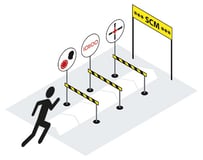5 Predictions for the Automotive Supply Chain in 2021
Brian Hoey - September 29, 2020

 People have been making educated guesses and predictions about the future of the automotive supply chain for as long as there’s been an automotive supply chain—many of them covering a span of decades in attempts to foresee evolution and growth. Some of these predictions can still act as guideposts, but, to put it bluntly, any predictions made before March of 2020 need to be carefully reexamined in light of the recent global supply chain disruptions.
People have been making educated guesses and predictions about the future of the automotive supply chain for as long as there’s been an automotive supply chain—many of them covering a span of decades in attempts to foresee evolution and growth. Some of these predictions can still act as guideposts, but, to put it bluntly, any predictions made before March of 2020 need to be carefully reexamined in light of the recent global supply chain disruptions.
This isn’t to say that all of the old predictions need to be thrown out—surely the trajectory of things like autonomous vehicles, green footprint optimization, and electric mobility will only be impacted in smaller ways, rather than thrown off course altogether—but simply that we need to rethink which of our expectations are still realistic and which no longer make sense in the current global environment. Some of our old assumptions will no doubt continue to hold, but some things about the value stream are likely going to undergo permanent change.
1. The Coronavirus Recovery Will Be Uneven
It’s neither bold nor controversial to suggest that the global recovery from the coronavirus crisis will be distributed unevenly throughout different countries and regions. While many countries in Europe are already able to get robust manufacturing and shipping processes back online, other parts of the world are still fighting off the pandemic—making it difficult to maintain consistent shipping and production flows. Even into next year this disparity will likely persist, and the automotive industry will be particularly impacted by it. Why? Because the average automobile requires parts to be sourced in vast numbers from a host of different suppliers. This results in particularly complex supply chains that are often difficult to get a handle on. We saw the way that China’s industrial shutdown threw supply streams into disarray all over the world—resulting in slowdowns and parts shortages across the board. We expect this kind of disruption (albeit not always on this scale) to become commonplace—meaning that automakers who rely too heavily on a small number of suppliers or fail gain full visibility into those suppliers will suffer.
2. Automakers Will Increase Supplier Diversity
For precisely the reasons that we sketched out above, the relationships between manufacturers and their suppliers is likely to change drastically. Since it’s no longer feasible to work with a geographically-limited set of supply chain partners without expecting disruptions, supply networks will have to become simultaneously more diverse and more agile across the board. This means creating supporting business processes that enable you to integrate with your suppliers and engage with them in a dynamic way, e.g. choosing how much to order, from whom, and when, all based on real-time streams of data. With real technology integration, you can also gain visibility into your suppliers’ value streams, to better understand your level of risk in any given sourcing transaction. Thus, as single-sourcing becomes less and less feasible for Agile manufacturers, the IT needs to support sourcing will become more exacting.
3. Supply Chain Responsiveness Will Be More Important Than Ever
In the prediction above, we noted the potential value of real-time information for monitoring your supply situation and powering smarter sourcing decisions. In point of fact, real-time data—and real-time data analysis by way of AI and advanced analytics—is going to become an increasingly crucial tool as planners seek to maintain responsiveness. If, for instance, uneven demand fluctuations across different geographies stand to complicate the workings of your production network, you’ll need to 1) sense those demand changes as early as possible by monitoring different market indicators, 2) perform production replannings across your network to reflect those shifts in demand, and 3) adjust transport routing plans dynamically ahead of time so as to avoid shelling out cash for premium freight. In other words, you'll have to identify and respond to changing conditions more quickly than ever. Where once a high level of responsiveness might have been seen as a luxury or a value add, it will increasingly just be the price of admission for the modern supply chain.
4. Connectivity Will Continue to Increase
So far, we’ve talked a lot about how the supply chain landscape will change to reflect the increasing volatility of global supplier and consumer markets—but what about technology and buying trends that were already playing out? Like we alluded to at the beginning of this piece, many existing trends will either continue apace or accelerate in 2021, including the trend towards increased connectivity in automobiles themselves. The more drivers come to expect things like driver assistance and alerts, the more complex a given automobile’s software has to be. In recent years, this has led automakers to essentially compete with tech companies for coding talent in order to create the software necessary to build competitive products. As cars become increasingly connected and networked together—in advance of the actual adoption of fully-autonomous vehicles—this pressure to functionally act as a development shop will only increase. While this will potentially present staffing issues and technical challenges, it can also present opportunities from a supply chain perspective. Simply put, increased connectivity leads to increased data—automakers who are able to capture and analyze this data will gain insights into consumer behavior that can then be leveraged into smarter products and processes.
5. Transportation Forecasting Will Be More Important Than Ever
For any number of the reasons we’ve already discussed, securing freight capacity is going to become both more difficult and more critical in the immediate future. Freight carriers are already being more selective with what they’ll carry, and, since there’s more demand than supply for capacity right now, it’s really a carrier’s market. Again, automakers are in a particularly thorny situation: they need to remain flexible when it comes to their transportation flows, but they also need to lock in capacity at favorable rates as soon as possible—all of which is exacerbated by the size and shape of the automobiles themselves. One of the best options in this department is to adopt a transportation forecasting solution to complement your existing TMS. By using live transportation data to estimate future capacity and pricing based on specified parameters, you can secure favorable rates for shipments that don’t even exist yet. Rather than being stuck with a several-day window for making shipping arrangements as orders come in, you can take a smart, proactive approach to managing freight capacity. In an era where flexibility and adaptability are going to keep getting more important, this can be an incredibly valuable tool.
LATEST POSTS
- Understand Circular Economy in The Manufacturing Industry
- How Can Industry 4.0 IT Integration Be Achieved Smoothly?
- The Significance of Order Sequencing in Discrete Manufacturing
- How to improve your Supply Chain Management: The Power of Control Towers
- Optimizing Human Resource Scheduling in Manufacturing: A Technological Approach



